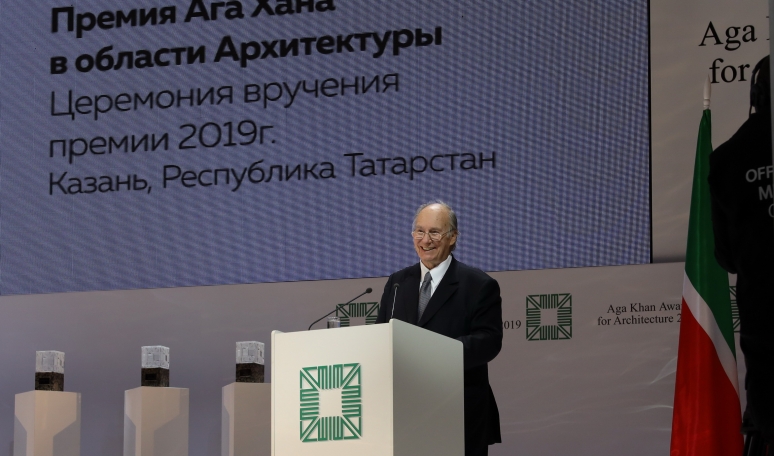The six winning projects of the 2019 Aga Khan Award for Architecture (AKAA) were acclaimed on September 13 at a ceremony held at Kazan’s Musa Jalil State Academic Opera and Ballet Theatre.
Mintimer Shaimiyev, State Counselor of Russia’s Republic of Tatarstan, accompanied His Highness the Aga Khan, hereditary Imam (spiritual leader) of the Ismaili Muslims, in presiding over the Award Ceremony.
“You are implementing the largest charitable, educational and humanitarian projects, support proactive, creative people, regardless of nationality or confession,” said Mintimer Shaimiyev in acknowledging the contribution of His Highness the Aga Khan. “Your peacekeeping mission, your commitment to bringing civilizations closer and achieving unity in diversity is consonant with our goals, especially to me, as the UNESCO Special Envoy for Intercultural Dialogue.”
Speaking at the ceremony, His Highness the Aga Khan noted that on this visit to Tatarstan, he had seen “how committed people can honor the power both of cultural identity and cultural pluralism.”
“It is striking to see how churches and mosques, for example, have been built and preserved right next to one another as powerful symbols of a profound intercultural dialogue,” he said.
These were examples, the Aga Khan explained, of what the world was in particular need of today, as we seek to meet accelerating environmental, social, technological, economic and political challenges.
Speaking about the theme of “Architecture in Dialogue”, which emerged from this 14th cycle of the Award, the Aga Khan explained the potential of the architectural world to inspire and enrich creative dialogues, embracing diverse and even divergent perspectives. “The rich architectural dialogue we seek to foster should include a renewed respect for the diversity of Islamic cultures themselves,” he said. It was also necessary, he added, to foster a dialogue with non-Islamic cultures including diverse religious traditions. “Architecture can lead the way in this effort – as we listen to one another and learn from one another across old divides.”
The Aga Khan went on to explain why the Ismaili Imamat was involved with architecture. “The simple answer lies in my conviction that architecture – more than any other art form – has a profound impact on the quality of human life,” he said. “I believe that we all have a responsibility to improve the quality of life whenever and wherever the opportunity arises. Our commitment to influencing the quality of architecture – intellectually and materially – grows directly out of our commitment to improving the quality of human life.”
The six Award recipients, spanning three continents, include an urban heritage intervention, a floating school, a national museum, an ambitious program to introduce public spaces across hundreds of localities, a university’s classrooms and halls, and an ecological center.

The winners of the 2019 Aga Khan Award for Architecture, who will share US$ 1 million between them, are:
Bahrain
Revitalization of Muharraq, which highlights the World Heritage site’s pearling history, was first initiated as a series of restoration and reuse projects. The project evolved into a comprehensive program that aimed to re-balance the city’s demographic makeup by creating public spaces, providing community and cultural venues, and improving the overall environment.
Bangladesh
Arcadia Education Project, in South Kanarchor, a modular structure – incorporating space for a preschool, a hostel, a nursery and a vocational training center – that takes a novel approach to a riverine site that is often flooded for five months every year. Rather than disrupting the ecosystem to create a mound for building, the architect devised the solution of an amphibious structure that could sit on the ground or float on the water, depending on seasonal conditions.
Palestine
Palestinian Museum, in Birzeit, which crowns a terraced hill overlooking the Mediterranean and is the recipient of the LEED Gold certification because of its sustainable construction. The zigzagging forms of the Museum’s architecture and hillside gardens are inspired by the surrounding agricultural terraces, stressing the link with the land and Palestinian heritage.
Russian Federation
Public Spaces Development Program, in the Republic of Tatarstan, a program that, to date, has improved 328 public spaces all over Tatarstan. The ambitious program sought to counter the trend toward private ownership by refocusing priorities on quality public spaces for the people of Tatarstan. It has now become a model throughout the Russian Federation.
Senegal
Alioune Diop University Teaching and Research Unit, in Bambey, where a scarcity of resources led to the use of bioclimatic strategies, including a large double roof canopy and latticework that avoids direct solar radiation but allows air to flow through it. By employing locally familiar construction techniques and following sustainability principles, the project succeeded in keeping costs and maintenance demands to a minimum, while still making a bold architectural statement.
United Arab Emirates
Wasit Wetland Center, in Sharjah, a design that transformed a wasteland into a wetland and functioned as a catalyst for biodiversity and environmental education. While its indigenous ecosystem has been restored, it has also proven to be a popular place for visitors to appreciate and learn about their natural environment.
The Aga Khan Award for Architecture’s mandate is different from that of many other architecture prizes: it not only rewards architects, but also identifies municipalities, builders, clients, master artisans and engineers who have played important roles in the realization of a project. Prizes have been given to projects across the world, from France to China. Architects and planners from New York to Dhaka have received one of 122 awards. During the nomination process, more than 9,000 building projects have been documented. The Award was established by His Highness the Aga Khan in 1977 to identify and encourage building concepts that successfully addressed the needs and aspirations of communities in which Muslims have a significant presence.







